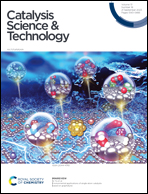Cyclometalated C^N diphosphine ruthenium catalysts for Oppenauer-type oxidation/transfer hydrogenation reactions and cytotoxic activity†
Abstract
The cyclometalated acetate ruthenium complexes [Ru(C^N)(η2-OAc)(dppb)] (dppb = 1,4-bis(diphenylphosphino)butane; HC^N = 2-phenylpyridine 1, benzo[h]quinoline 2, 1-phenylpyrazole 3, 2-phenyl-2-oxazoline 4) are easily obtained in 58–74% yield through a one-pot synthesis from [Ru(η2-OAc)2(dppb)] and the corresponding phenyl substituted N-heterocycle in methanol via elimination of HOAc. These complexes have been characterized by single crystal X-ray diffraction studies. Protonation of 2 with HCO2H (5 equiv.) in toluene affords the formate [Ru(C^N)(η2-HCO2)(dppb)] (5) isolated in 75% yield, without release of the HC^N ligand. The derivatives 1–4 display catalytic activity in the Oppenauer-type oxidation of secondary alcohols to ketones at S/C = 1000, using acetone or cyclohexanone as hydrogen acceptor and KOtBu as base in toluene, with TOF up to 12 000 h−1 for 4. Complexes 1–4 at S/C = 1000 are also active in the TH of carbonyl compounds to alcohols in 2-propanol employing NaOiPr, with TOF up to 14 300 h−1 for 4. The evaluation of the cytotoxic activity of these complexes against U87 glioblastoma cancer cell line via MTT test affords IC50 values ranging from 1.4 to 4.1 μM.



 Please wait while we load your content...
Please wait while we load your content...